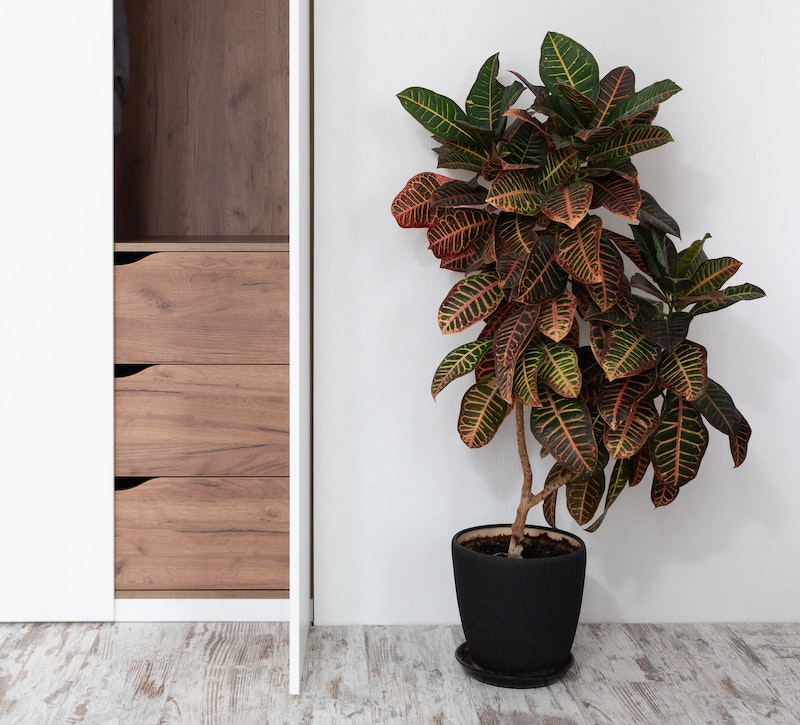Growing Crotons
The brilliant, patterned leaves of crotons add a stellar splash of color to interiorscapes. Numerous cultivars offer a range of growing heights, leaf shapes, and foliage colors. Some compact types remain under 20 inches and others grow up to 10 feet tall in their native habitat, although most kept as houseplants stay under a few feet high. In subtropical and warmer areas, they grow outdoors as shrubs or potted specimens, but since they are sensitive to temperatures under 50 degrees Fahrenheit, they are kept indoors for much or all of the year in cooler areas.
Crotons are slow to moderate growers, putting on no more than about 12 inches of new growth per year. A beginner grower can certainly succeed with crotons, especially if they provide the ideal environment and growing conditions.

Croton Sunlight Requirements
Proper light intensity is critical to getting the best color out of a croton. Indoors, the best light for a croton is bright and indirect, although a period of direct sunlight daily may be suitable for certain cultivars. Plants kept outdoors typically perform best in partial shade. In cooler climates where sunlight is less intense, they may tolerate more sun exposure, especially if allowed to acclimate slowly. New leaves of croton normally appear green before developing leaf coloration, so this should not cause alarm. Too much direct light gives the foliage a dull, gray appearance.
Planting Crotons
The best soil for crotons is moist and well drained. They are fairly heavy feeders, so choose a mixture that is rich, with ample organic matter, such as well-rotted compost. One possible mixture might include equal parts peat moss, compost, and perlite. These houseplants like a mildly acidic growing medium, performing well within a pH range of about 5 to 6.5. Crotons have a strongly upright habit, which can lead to this plant becoming top-heavy. Make sure any container is heavy enough to avoid the plant toppling over as it grows. Transplant the croton every two years, choosing a container only about an inch larger than the existing pot. Perform this transplant and any pruning to shorten or tidy the plant early in the growing season.

Watering Crotons
Regular moisture encourages crotons to thrive. This plant needs about an inch of irrigation or rainfall weekly while actively growing. Young leaves wilting is one sign that a croton may be under drought stress. Crotons love high humidity, so consider keeping this houseplant on a pebble tray, positioning it near a humidifier, or regularly misting it. The plant’s water needs are much less during fall and winter when light levels and temperatures drop. Check the soil about an inch below the surface with a probing finger and only water when the soil feels dry to the touch. Avoid using softened water to irrigate; instead, opt for rainwater, distilled water, or tap water that has been allowed to sit for a few days.

Fertilizing Crotons
Fertilize this houseplant monthly during the growing season. Dilute a water-soluble fertilizer to half strength and deeply water the croton. If the soil is very dry, water the plant deeply and then a day or two later apply the fertilizer. Alternatively, apply a slow-release, granular fertilizer labeled for foliage houseplants at the recommended rate twice during the growing season. Choose a balanced fertilizer with an NPK ratio of 10:10:10 or with a higher nitrogen ratio such as 3:1:2.
Common Croton Problems
A handful of pests may occasionally bother crotons. These include mealybugs, scales, thrips, and mites. Inspect the croton thoroughly before bringing it indoors if it was kept outdoors in the summer. Occasionally wipe leaves with a damp cloth. Leaf spots and bacterial disease can also affect crotons. Avoid splashing leaves when watering the plant and use only clean tools when pruning the croton. Crotons rarely bloom as houseplants, but maintaining the perfect environment for the plant will encourage flowers to develop. Poor water management can force leaves to wilt and die.
Propagating Croton
Crotons are typically not propagated using seeds, since offspring will not necessarily develop the attractive leaf color and pattern of the parent plant. Instead, division and stem cuttings are top choices for propagation. For stem cuttings, use a sharp tool to cut off a 4-inch section with at least 3 leaves from the top of a stem just above a leaf node. Dip the end of the cutting in rooting hormone, if available, and then stick the cutting gently in moistened soil so it is about an inch deep. Use a clear plastic bag or tray cover for a week or two to reduce moisture loss around the cutting. A successful cutting will show root development within about 4 weeks. To divide a croton, remove the plant from its container and gently separate offshoots from the parent plant. Replant them in smaller containers and monitor moisture closely until new growth emerges.

Growing Crotons Outdoors
In USDA zone 10 and 11, crotons can be planted in the ground and survive year-round; in cooler areas, they make an excellent seasonal addition to a backyard or patio. In fact, bringing this plant outdoors when light, temperature and humidity conditions are ideal can encourage blooming. Crotons require that temperatures remain above 50 degrees Fahrenheit and prefer a temperature around 70 degrees. Dieback will occur with excessively cold temperatures. When bringing a croton outdoors seasonally, acclimate it to more intense light and temperature fluctuation over about a week to avoid shocking the plant.
 |
Author Angela Ryczkowski - Published 2-25-2023 |
